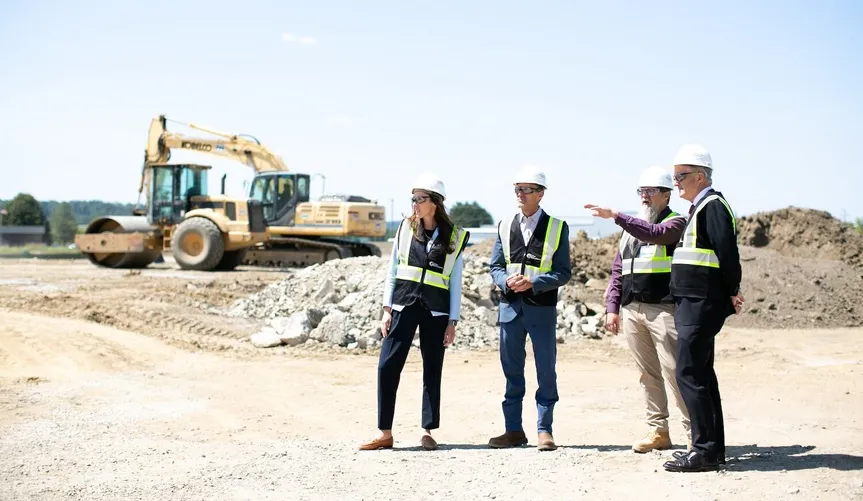A big facility for recycling lithium-ion batteries is now operating in Central Ohio, where workers are busy salvaging and repurposing the metals and minerals needed to drive the clean energy transition.
On Thursday, Cirba Solutions officially opened its expanded battery recycling plant in Lancaster — making it the first project of any kind to come online after receiving funding from the Biden administration’s Bipartisan Infrastructure Law, which passed in 2021. Cirba Solutions snagged more than $82 million in total federal grants to help scale its operation and meet the nation’s rising demand for key battery ingredients.
The $400 million expansion project includes two new processing lines that can together produce 15,000 tons annually of “black mass” from batteries — a cakey, powdery substance rich with materials such as lithium, nickel, cobalt, and manganese. Another wing of the recycling complex is slated to be operational by 2026. (Canary Media toured the facility before its expansion in late 2022.)
At full scale, the Ohio recycling plant will be able to churn out enough battery-grade metal salts to power 250,000 new electric vehicle batteries every year, the company claims. For context, a record 1.2 million EVs were sold in the United States in 2023, according to Kelley Blue Book.
“A lot of our energy and transportation needs are already, and increasingly going forward, going to have batteries at the core — they’re in cars, they enable us to integrate renewables into the grid,” said Giulia Siccardo, director of the U.S. Department of Energy’s Office of Manufacturing and Energy Supply Chains, or MESC.
“We have an opportunity now through this energy transition … to move from a system that is linear and extractive to something that is circular and much more sustainable,” she told Canary Media by phone from Lancaster, following an afternoon ribbon-cutting event.
Cirba Solutions, which is headquartered in Charlotte, North Carolina, is among the dozens of federally backed companies scaling up facilities for extracting raw battery materials. As more households and businesses adopt EVs, hybrid cars, e-bikes, and energy storage systems, the need for battery metals and minerals is expected to surge. So, too, is the amount of e-waste that those products leave behind — unless those spent batteries are repurposed.
The MESC office has awarded over $1.8 billion through the Bipartisan Infrastructure Law to support 14 projects for making, processing, and recycling battery materials at new or retrofitted facilities. That includes a $75 million grant for Cirba Solution’s Ohio expansion, which separately received a $7.4 million grant from the Department of Energy to support second-life applications for EV batteries.
The Inflation Reduction Act, the keystone of U.S. climate policy, includes additional provisions to incentivize domestic battery recycling, including the 45X advanced manufacturing production tax credit. The Department of Energy’s Loan Programs Office has also made a $2 billion conditional loan commitment to Redwood Materials to build a $3.5 billion lithium-ion battery recycling plant in McCarran, Nevada.
The investments are part of the Biden administration’s broader push to produce more battery materials domestically, both to reduce the nation’s reliance on overseas suppliers like China, which dominates battery manufacturing, and to limit the potential for unchecked environmental harm and human-rights violations in international mining operations. To increase U.S. supplies, the government is pushing to expand mining activity in states like California and Nevada — though the efforts face opposition from local Indigenous communities and environmentalists.
Battery recycling offers another route to self-sufficiency, Siccardo said.
“It’s exciting from a supply chain security and energy security standpoint if we no longer need to be dependent on imports,” she said. “We’ve got a lot of what we need right here, and we can just put it to work.” She added that battery waste from laptops, smartphones, and other consumer electronics is also piling up.
Along with its Ohio plant, Cirba Solutions operates five battery processing locations in North America and plans to more than double that number by 2030 to handle the influx of spent and discarded batteries.
The Buckeye State is a major notch in the so-called Battery Belt that’s emerging across the Midwest and southeastern U.S. as industrial heavyweights build multibillion-dollar EV-battery and car-assembly plants. In Lordstown, Ohio, General Motors and LG Energy Solution are making EV batteries from a 2.8-million-square-foot factory run by their joint venture, Ultium Cells. LG is also partnering with Honda to build a 2-million-square-foot EV-battery production facility in the city of Jeffersonville, which is expected to be completed by the end of this year.
Generally, new battery factories can have scrap rates of over 30 percent as they’re ramping up to full capacity, Siccardo said. Most of the lithium-ion waste the Ohio facility receives today comes directly from battery manufacturers — and many of the materials that the new Ohio factories produce will likely wind up in recycling facilities like Cirba Solutions’ plant in Lancaster too.
“We’re going to create a closed-loop material processing system in Lancaster, where we can return all those elements back into the domestic supply chain,” David Klanecky, CEO and president of Cirba Solutions, previously told Canary Media.

